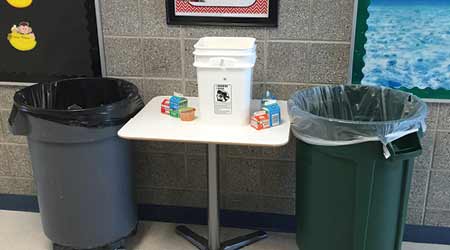
To facilitate a smooth rollout at participating Salt Lake City schools, Katie Kapusta, field supervisor for the child nutrition program, works closely with kitchen staff, school principals and custodians.
“We had to revise our menu so that we were using more prepackaged items,” she says. “They’re easier for the students, and there’s less mess for the custodians.”
The food service staff also avoids supplying foods that can spill easily, such as condiments and cereal with milk.
To handle trash, custodians use garbage and recycling containers from the cafeteria and set up stations outside the classrooms so that students can throw their trash out after eating. The cans are then emptied and returned to the cafeteria in time for lunch.
Some schools require extra receptacles or milk buckets and strainers to collect leftover liquids.
“There’s no one-size-fits-all approach,” says Ricky Martinez, the assistant custodial supervisor assigned to support Backman during the transition. “You have to adjust to the school’s structure.”
Backman requires five-gallon buckets with strainers to collect milk outside the classrooms. Other schools allow students to pour unfinished milk into sinks found either inside or outside the classrooms. Food Service will provide strainers for the sinks to prevent straws from going down the drain.
According to Mike Rhoten, head custodian at Washington Elementary School, pouring milk down the hallway sinks can get messy and often requires extra cleanup.
“Sometimes kids leave their milk cartons in the sink, so I have to clean the sinks and countertops every day,” he says. “I also have to mop the hall in that area because milk gets on the floor. It’s a little more work for me, but it comes with the territory. And if it means more kids are eating with this program, then I’m okay with it.”
Cleaning Challenges With Breakfast In The Classroom
Responding To Spills

 The Down and Dirty on Cleaning in Virus Season
The Down and Dirty on Cleaning in Virus Season How Surfactant Use is Expanding in Commercial Cleaning
How Surfactant Use is Expanding in Commercial Cleaning Operational Excellence Series 2025: Labor Strategies
Operational Excellence Series 2025: Labor Strategies
